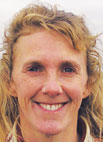
Larry Deffenbaugh looked for several things when he was getting back into the cattle business in 1990. "I wanted something no one else had. I had grown up around white-faces and Angus. I looked at different trade magazines, and then I found three years of a feedlot test.” What he found was the Salers. “Salers responded to feed and their weight conversions were good," Larry recalled. With their stats showing for good conversions, his desire for a good-gaining animal was met. Upon further investigation, Larry found the Salers to be a breed with wide pelvic openings, calving ease and a great disposition.
“We rarely have any calving problems, because we maintain our birth weights at less than 80 lbs. For years most of our calves were 65 and 68 lbs. We’re up to around 70 lbs. now,” he said.
Larry said Salers are special because they were traditionally meat and dairy cows in their native France. This translates well into Larry’s herd.
"They are consistently very good milkers, with maternal instincts and characteristics that are very strong," he said.
Larry's herd, found at his sprawling ranch just west of Carthage, Mo., is marketed mostly as a commercial herd, although Larry does use AI to improve his herd’s genetics for the show circuit.
“People who really know the Salers, who know EPDs and pedigrees, we market to those people, but then, other people just look at phenotypes. Their build size, their udder structure,” Larry said. He said many times he’s had his cattle at shows and people come up and comment on his “great looking Angus cattle,” or ask him, “is that a Red Angus?”
Originally, Salers introduced into the U.S.A. in the 1960's were red, curly-haired and horned. But Larry has tried to cater to the market and breed for purebred black, polled Salers.
The typical curliness of Salers’ hair has been bred out over the years in the U.S. Larry thinks much of that may be from the environment. “They are very tolerant of the cold,” he said. The further south they are, the less hair they seem to have, he noted. This has been an advantage to him in recent winters with several rough ice storms. “It seemed all they would do is stand and eat all day,” he said, of his cattle trying to stay warm. But they persisted, even in the cold, thanks to that tolerance.
Larry breeds using AI almost every year, but he is very busy as he is a gastroenterologist serving three hospitals, two in Joplin, Mo., and one in Carthage. He has hired hands that help around the farm, especially now that his four children are grown and have moved away. Larry’s wife, Elizabeth, also grew up on a farm, but as life would have it, her four children live far away, so she and Larry rely more on the help of others now than ever.
“We maintain animal records to establish EPD's and for Salers registration. That includes birth weights, 205-day weaning weight, hip height, girth and scrotal diameter,” Larry said. They keep all the numbers, and Larry said he tries to offer more protein in their diet to offset the differences he sees between his and northern located Salers. There’s just not enough protein in our grass, compared to native grasses in the Western and Northern U.S., he noted.
One way Larry has tried to boost his herd's feed rations is through a new input. He uses a liquid ethanol byproduct to add much-needed protein.
“They have free access to that. They’ll eat anything we put it on, almost,” he noted. When asked if the byproduct has proven cost effective, Larry noted, “I haven’t found anything to be particularly cost effective the past two years,” he said. But the byproduct has proven to be a worthy addition to the diet.
The Deffenbaughs show locally and regionally. They try to improve their genetics all the time, and bull selection is very important to that process. Larry told a story of one year, showing a bull of his in Denver. “We use lines like Chuckwagon and Genesis and Heavy Duty and Escalade. We had a Chuckwagon son we took to Denver, he had done very well. He went through the show and placed fourth. He was going to be sold for a (great) price when I realized I couldn’t buy a better bull, so I just brought him home,” Larry recalled.
This bull has proven himself, as Larry said he’s improved his overall herd and added a degree of consistency.
“Over time we’re moving to black. Some people believe black does better in the show ring; perhaps that’s because black looks fuller or because people are color blind,” he noted, saying his preference is for the reds, perhaps because of his early days raising Herefords.
Larry said that with his busy lifestyle, he has kept cattle because he enjoys having them. His future in the cattle industry involves keeping cattle until he can’t enjoy them anymore. “I had an old farmer tell me once he wasn’t worried about dying, he just didn’t want to leave the farm.”
We think this busy doctor and cattleman shares a similar sentiment.







